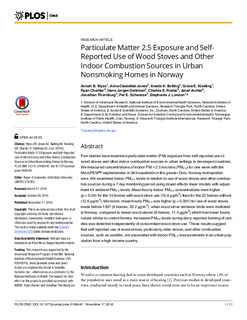Particulate Matter 2.5 Exposure and Self-Reported Use of Wood Stoves and Other Indoor Combustion Sources in Urban Nonsmoking Homes in Norway
Archer, Janet; Dahlman, Hans Jørgen; Rodes, Charles; Schwarze, Per E; Chartier, Ryan; Bølling, Anette Kocbach; Jones, Anna Ciesielski; Wyss, Annah B.; Thornburg, Jonathan; Kissling, Grace E.; London, Stephanie J.
Peer reviewed, Journal article
Permanent lenke
http://hdl.handle.net/11250/2424819Utgivelsesdato
2016Metadata
Vis full innførselSamlinger
- Artikler [5068]
- Publikasjoner fra CRIStin FHI [7544]
Originalversjon
10.1371/journal.pone.0166440Sammendrag
Few studies have examined particulate matter (PM) exposure from self-reported use of wood stoves and other indoor combustion sources in urban settings in developed countries. We measured concentrations of indoor PM < 2.5 microns (PM2.5) for one week with the MicroPEM (TM) nephelometer in 36 households in the greater Oslo, Norway metropolitan area. We examined indoor PM2.5 levels in relation to use of wood stoves and other combustion sources during a 7 day monitoring period using mixed effects linear models with adjustment for ambient PM2.5 levels. Mean hourly indoor PM2.5 concentrations were higher (p = 0.04) for the 14 homes with wood stove use (15.6 mu g/m(3)) than for the 22 homes without (12.6 mu g/m(3)). Moreover, mean hourly PM2.5 was higher (p = 0.001) for use of wood stoves made before 1997 (6 homes, 20.2 mu g/m(3)), when wood stove emission limits were instituted in Norway, compared to newer wood stoves (8 homes, 11.9 mu g/m(3)) which had mean hourly values similar to control homes. Increased PM2.5 levels during diary-reported burning of candles was detected independently of concomitant wood stove use. These results suggest that self-reported use of wood stoves, particularly older stoves, and other combustion sources, such as candles, are associated with indoor PM2.5 measurements in an urban population from a high income country.
